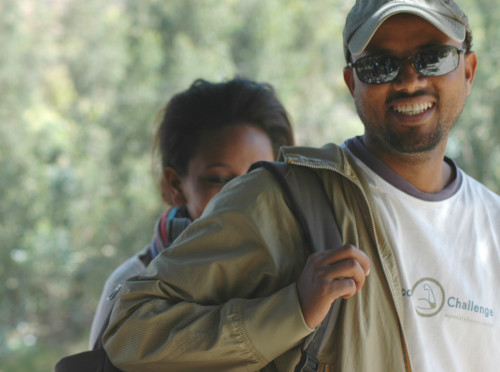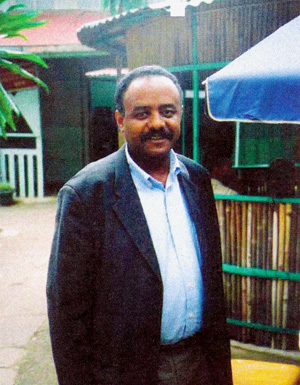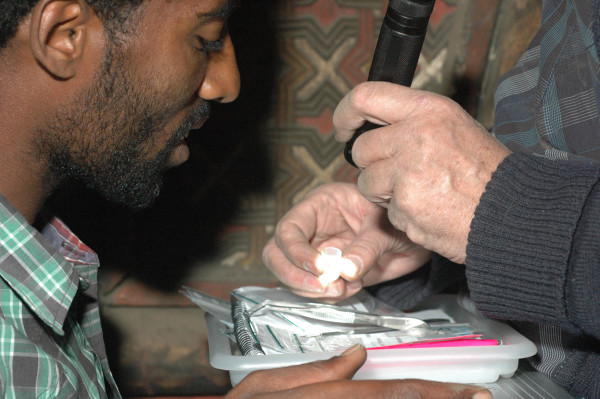HANDS ON TRAINING and graduate education in conservation as well as basic supervision in care taking and management of heritage of responsible persons at location is a main concern for SCECH, stated in our charter. This goes along with the vision we share with our friends and colleagues in Ethiopia to create a long-term program of conservation and education, with a view to taking care of and protect the priceless cultural properties that belong to this country, not just for the Ethiopian people, but also for the entire international community.
This was one of the main issues during the workshop in Addis Ababa 2013 Restore or Lose Forever – The Urgent Need for the Conservation of Historical Heritage: the Case of Yimrihane Kristos, which 2015 was followed up by another workshop in the Capital and a consultative meeting in Lalibela entirely dedicated to this (find links to presentations of these meetings on the bottom of this page).
The head priest, Abba Welde Qirqos, experiences to strike away dust with a brush made of badger hair on one of the pillars in the Church of Yimrihane Kristos during the examination 2012. Different ways of basic cleaning which does not harm building and paintings is one important part of ongoing management of heritage. © SCECH
Practical training in field and theoretical education at university are both necessary parts in order to become a restorer. These in turn presuppose ongoing projects of conservation and we hope that the Yimrihane Kristos pilot project in this regard will become the starting point. When the funding is secured this twofold education of students in conservation as well as supervision in different kind of basic care taking and heritage management at spot directed towards priests and locals themselves, will make an important part. This educational concept on different levels in order to create a domestic profession of restorers and to communicate know how on preventive conservation in order to assist the locals to keep their heritage in good condition and prevent further damages, answer to a longstanding wish from the Orthodox Tewahido Church, Authority for Research and Conservation (ARCCH) as well as from the Ethiopian Universities.
The SCECH conservation team during the examination 2012, which enlarged by other experts in building and painting conservation is ready to deliver different kind of practical training during the planned conservation project in YK. © SCECH
As to the practical part: SCECH conservation team, enlarged with other experts connected to this society, are prepared to deliver hands on education in architectural and painting conservation during the YK project to Ethiopian trainees who have decided to become restorers and accordingly also accept to attend the theoretical part of the education. As to the theoretical: a first tentative sketch for a long-term development of graduate education in Ethiopia, including doctoral studies which opens for domestic research in conservation, based on the concept of how higher education use to be organized internationally, has been made by Professor Bosse Lagerqvist, member in SCECH and Head of Department of Conservation at Gothenburg University. It was created to serve as starting point for a discussion with colleagues at the Ethiopian Universities about what could be done in the long run and was at the workshop in Addis Ababa 2015 presented by Dr. Jacob Thomas, member of SCECH and himself a researcher in conservation at the same department.
MA Tadesse Girmay, architect and teacher at Addis Ababa University (Dept of EiABC), presented 2009 his MA thesis on one of the famous medieval monasteries in Ethiopia: A study on the Conservation of the Monastery of Gunda Gundo (Eastern Tigrai). He visited us in Sweden already in 2011 and is one of the a key figurers in our project. © SCECH
A new workshop dedicated to these issues and to discuss a joint plan with our Ethiopian friends for how this educational program could be integrated in different phases of the YK project as well as the issue of fund raising, is planned to take place in Sweden during the autumn 2016. We in SCECH will here together with key persons from YK and the Lasta province, the Church and Universities in Ethiopia, get the opportunity to agree on details in this plan and discuss how the budget should be done in order to be accepted by all parts involved and to find out appropriate ways of financing. To this meeting will also Mr. Stephen Battle, Architect and Program Director for the Sub-Saharan Africa branch of World Monuments Fund be invited.
Other important persons in our network connected to YK are, besides the head priest of YK in the photo above, Abba Haile Gabriel, responsible for all churches in the Lasta province and Woitzerit Adera, Head of the cultural office in Lalibela, the two representatives from the same office to the left and right in the photo (which names right now are forgotten) and the man in the middle, Ato Tenaw Getahun, restorer from ARCCH in Addis Ababa who was their controller during our examination. © SCECH
Find below the concept document of the YK pilot project of conservation and Professor Lagerqvist’s tentative plan for development of graduate education:
Conservation in Ethiopia – a Pilot project
The Ethiopian churches from the 6th to the 19th century accommodate works of art, which are unique and priceless, a religious and cultural heritage, which, if nothing is done, will be ruined. Magnificent paintings on walls and in ceilings, executed in al secco on plaster and in tempera on canvas glued to wall, are often in bad shape and in acute need of restoration. In Ethiopia, the professional knowledge and financial means needed to take charge of this are largely missing.
Our ambition is to carry out a pilot project in one of these endangered churches and here preserve the murals and ornamental painting in need of conservation. This presupposes that technical investigations are done, working instructions are established and permissions from relevant cultural and ecclesiastical institutions in the country are granted. As an answer to the need of a domestic education an important part of the project will be devoted to apprentice education, i.e. trainees are invited to receive basic training in painting conservation on location. This will in turn create a basis for further education. As the local establishing is of outmost importance recruitment of staff, besides the trainees, will, as far as possible, be made in Ethiopia and simpler task as well as basic instructions of care taking will be handed over to the local cultural authorities and priests and monks themselves. This will ascertain that no further damages are done while, awaiting professional aid and establish a co-operation on location which is psychologically right and meaningful for all of us.
So this pilot project will become a didactic model for how conservation and education in a broader sense can be carried through in Ethiopia. This will hopefully in turn open for a larger, long-term programme of conservation and education in the country, financed by SIDA or EU or in joint venture with private sponsors to the benefit of the great cultural legacy of Ethiopia.
Equestrian Saint. Detail from the eastern wall, north aisle in the Church of Yimrihane Kristos. Presumable from the 12th century, al secco on wall. Attribution unknown. © SCECH
An organisation named The Society for the Conservation of the Ethiopian Cultural Heritage (SCECH) has in 2011 been established in order to support this project. The members of the society represents professions on highest level as well as scientific and cultural institutions with extensive educational potential of great value at the implementation of the pilot project as such as well as at the planning of the enlarged project towards which this one is aiming (for further information about SCECH, see Charter).
As a way of making the project as well as this part of the Ethiopian artistically legacy in a broad sense public to the world, a documentary is planned to be done by two experienced filmmakers working for the renowned French-German broadcast channel ARTE.
Our hope is that this pilot project will draw attention to the need for professional and financial aid in broader sense with a view to taking care of and protect these priceless cultural properties, not just for the Ethiopian people, but also for the entire international community.
Development and establishment of conservation education and research in Ethiopia
Tentative outline of possible development track
Formulated by Professor Bosse Lagerqvist, Head of Dept of conservation, University of Gothenburg after discussion with: Assoc. Prof. Charlotta Hanner Nordstrand (Dept of Conservation, Univ. of Gothenburg)
Prof. Samuel Rubenson (Centre for Theology and Religious studies, Lund Univ.)
PhD Candidate Mengistu Gobezei Worku (Centre for Theology and Religious studies, Lund Univ.) Prof. Karl-Gunnar Olsson (Architecture, Chalmers Univ. of Technology, Gothenburg) Prof. Inger Lise Syversen (Architecture, Chalmers Univ. of Technology, Gothenburg).
Professor Shiferaw Bekele, Addis Ababa University, recognized as one of the foremost historians in Ethiopia today and since many years a great spokes man for our project. © SCECH
First step (2015)
Workshop in Addis Ababa (14-16 May, 2015) with participants from the three universities concerned (Addis Ababa, Gondar, Mekelle), governmental bodies and other organisations of relevance, as well as representatives from Swedish partners. The intention with the workshop is to discuss the tentative outline, and more in detail the activities intended to form the second step.
Second step (2016 -2019)
Formulate a number of courses in total on the equivalent to between 40 to 60 ECTS, the length of each course is to be decided. These courses are to be given on part-time basis targeting professionals within the heritage field in Ethiopia. They need to be planned in cooperation with existing university departments of relevance in Ethiopia, so that facilities such as laboratories, studios and lecture halls could be used for the courses, as well as professors, researchers and lecturers within these departments would represent valuable teaching and mentoring resources. The target group, the potential students, should be professionals within the heritage sector. This group will also form the fundament for the ability to establish a full national education structure for conservation studies comprising bachelor’s and master’s levels. Out of these students a reference group will be established that will be a resource for defining the programme structure, course outlines, cooperative links with different university departments as well as heritage organisations and other governmental bodies of relevance. This reference group will also provide the coming conservation program with teaching capacities.
Belonging to the education in conservation is amongst several subjects that which concerns analytic work of materials that pertain to a heritage site before, during and after conservation. Here the painting restorer Peder Boellingtoft, expert in multispectral analyze, show his assistant Abraham during the YK examination how micro cuts on color not bigger than 4-5 mm are done in order to meet the scientific demands. © SCECH
Third step (2019 – 2022)
The conservation programme is running up to bachelor’s level, parallel to this the master’s level is defined with one or two in-depth strands. Later further strands would be developed depending on needs identified within the national and larger regional context, and the possibility to formulate cross-disciplinary cooperative options with other university departments, nationally as well as internationally. An inter-regional network for conservation education and research is established.
Fourth step (2022 – 2027)
The full programme structure is running and conservators with bachelor’s and master’s degree are operative within public bodies and organisations as well as in private companies, in activities on preserving, conserving, maintaining and developing the cultural heritage.
An inter-regional conference is organised in order to define research needs, funding options, requirements for starting a PhD-programme, and possible partners in a broader international perspective.
Fifth step (2027 -)
PhD-programme is running, doctoral degrees are awarded, and research projects could be established in national and international contexts.
Link to: Workshop program for meeting in Sweden 2016 (page in progress)
Read more: The SCECH’s conservation team and a brief project draft






